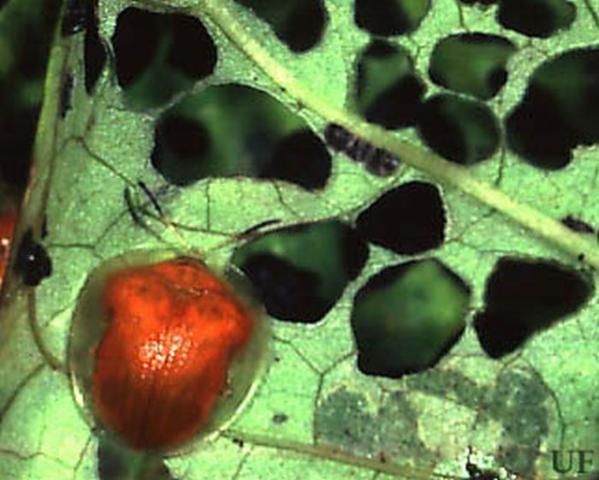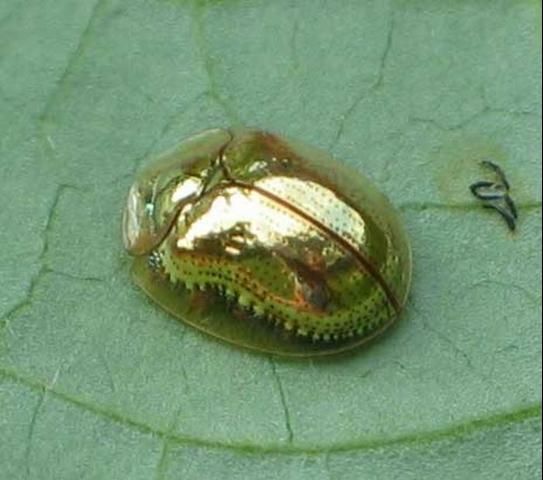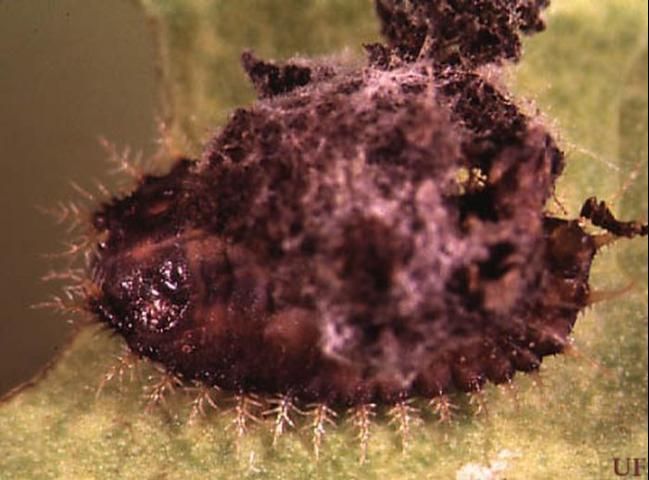The Featured Creatures collection provides in-depth profiles of insects, nematodes, arachnids and other organisms relevant to Florida. These profiles are intended for the use of interested laypersons with some knowledge of biology as well as academic audiences.
Introduction
Insects commonly known as "goldbugs" sometimes attract the attention of gardeners when they feed on plants in the family Convolvulaceae. Although these insects are occasionally abundant enough to cause serious levels of defoliation, they are mostly a curiosity.
Distribution
The golden tortoise beetle is distributed widely in eastern North America, west to about Iowa and Texas. It is one of three species of tortoise beetle found in Florida.
Life Cycle and Description
Very little biological information is available on this species, probably reflecting its slight economic importance. In the northern states there usually is only one generation annually. In New Jersey the beetles first appear in May or June, commence feeding on weeds, and deposit eggs soon thereafter. A new population of adults is evident in July. The new adults feed briefly before entering diapause until the following spring. Development time from egg to adult requires about 40 days. The number of generations per year is unknown in Florida.

Credit: Paul Choate, UF/IFAS

Credit: Lynette Schimming, bugguide.net
Adults
The adult beetles are distinctive in that the margins of the prothorax and elytra are expanded, largely concealing the head and appendages. The expanded margins are not pigmented, appearing nearly transparent. The beetles are fairly small, measuring 5.0 to 7.0 mm in length. The beetles vary slightly in color but invariably are orange colored, often golden metallic, and are sometimes called "goldbugs."
Eggs
The eggs are attached singly to the underside of leaves or on stems and are white in color. The eggs are oval and flattened. They measure only about 1 mm in length and hatch in 5 to 10 days. Eggs are deposited in clusters of about 20 eggs.
Larvae
Larvae are broad and flattened and adorned with branched spines. Their thoracic legs are short and thick, and unlike many chrysomelids they lack an anal proleg. The color of the larva is yellowish to reddish-brown. There are three larval instars. The larvae display the habit of carrying their cast skins and fecal material attached to spines arising from the posterior end of their body, a structure called an "anal fork." The anal fork is movable and is usually used to hold the debris over the back of the body, forming a "shield" that deters predation. Larvae mature in 14 to 21 days. Here is a video on YouTube from the Terra Explorer Project of a larva creating a fecal shield. Terra Explorer Project Video link http://www.youtube.com/watch?v=_BDxjUfyVEA&feature=plcp. Terra Explorere Project link http://www.terranat.com/.

Credit: Paul Choate, UF/IFAS

The mature larvae attach themselves to leaves by their anal end and pupate. Pupae are brownish in color. As is the case with larvae, the pupae bear spines. The fecal material and other debris carried by the larval stage may also remain attached to the pupa. The pupae measure 5 to 8 mm in length. Duration of the pupal stage is usually 7 to 14 days.
Host Plants
The golden tortoise beetle is associated with sweet potato and related species such as morning glory, Ipomoea spp. and bindweed, Convolvulus spp. Only plants in the family Convolvulaceae are hosts.
Damage
Both larvae and adults feed on foliage. The typical form of injury is the creation of numerous small to medium-sized irregular holes. Both stages usually inhabit the lower surface but eat entirely through the foliage. Rarely are tortoise beetles abundant enough to be considered damaging.
Natural Enemies
The wasp parasitoid Tetrastichus cassidus Burks (Hymenoptera: Eulophidae) and the fly parasitoid Eucelatoriopsis dimmocki (Aldrich) (Diptera: Tachinidae) are known to attack golden tortoise beetle. Also known to cause mortality, particularly among larvae, are such numerous ladybird beetle predators such as Coccinella spp. and Coleomegilla spp. (Coleoptera: Coccinellidae), but especially insects with piercing-sucking mouthparts such as damsel bugs (Hemiptera: Nabidae), shield bugs (Hemiptera: Pentatomidae), and assassin bugs (Hemiptera: Reduviidae). The "shield" carried by the larvae (see description of larvae below) is somewhat effective against small predators, but large predators, especially those with long piercing-sucking mouthparts, are not deterred.
Management
Larvae and adults are easily controlled by application of insecticides to the foliage, but this action is rarely warranted.
Insect Management for Sweet Potatoes, https://edis.ifas.ufl.edu/ig159
Selected References
Barber HS. 1916. "A review of the North American tortoise beetles (Chrysomelidae; Cassidae)." Proceedings of the Entomology Society of Washington 43: 113–127.
Capinera JL. 2001. Handbook of Vegetable Pests. San Diego, CA: Academic Press, San Diego.
Olmstead KL, Denno RF. 1992. "Cost of shield defense for tortoise beetles (Coleoptera: Chrysomelidae)." Environmental Entomology 17: 237–243.
Olmstead KL, Denno RF. 1993. "Effectiveness of tortoise beetle larval shields against different predator species." Ecology 74: 1394–1405.
Riley CV. 1870. Insects infesting the sweet-potato. Tortoise beetles (Coleoptera, Cassidae). Pages 56–64. In Second Annual Report of the Noxious, Beneficial and other Insects of Missouri. Jefferson City.
Riley EG. 1986. "Review of the tortoise beetle genera of the tribe Cassidini occurring in North America north of Mexico." Journal of the New York Entomological Society 94: 98–114.
Smith JB. 1910. "Insect injurious to sweet potatoes in New Jersey." New Jersey Agricultural Experiment Station Bulletin 229. 16 pp.